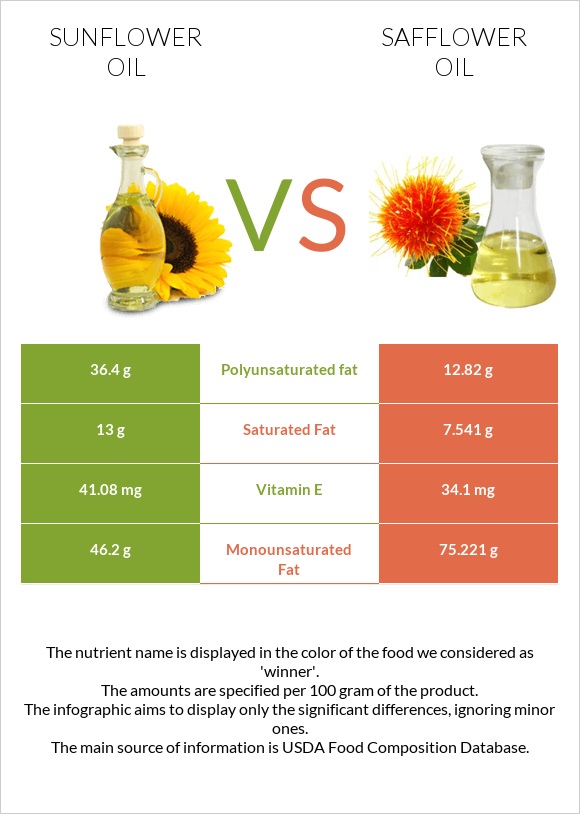Sunflower oil vs. Safflower oil — How Do They Differ?


Summary
Sunflower oil is richer in polyunsaturated fats and vitamin E. It is also higher in saturated fats. Safflower oil has a higher smoke point and is richer in monounsaturated fats. With richer monounsaturated fat content and a higher smoke point, safflower oil has an advantage over sunflower oil.
Introduction
This article compares two types of seed oils; sunflower oil and safflower oil. These oils are processed and derived from the seeds of each plant.
This article will compare these two oils according to general differences, nutritional content, and health impacts.
General Differences
Taste
They both have neutral tastes, so the taste doesn't mix with the food while cooking and frying. However, the difference that does exist is that safflower oil tastes more like canola oil than sunflower oil.
In this article, we can compare sunflower oil and canola oil.
Smoke point
Sunflower oil has a smoke point of 232°C, whereas safflower oil has a higher smoke point of 266°C.
Safflower oil can sustain higher cooking temperatures without releasing carcinogenic chemicals and smoking. This is an advantage that safflower oil has over sunflower oil.
Nutrition
In this section, we will compare 100g of each to one another.
Calories
They have similar amounts of calories.
Carbs and Protein
They are devoid of carbs and proteins
Fats
Although their total amount of fats equals 100% of their weight, their distributions differ.
Sunflower oil is richer in polyunsaturated fats but higher in saturated fats. In comparison, safflower oil is richer in monounsaturated fats.
Below we can visualize their distributions and ratios.
@fattypecoverage
Minerals
Their mineral profile is insignificant.
Mineral Comparison
Vitamins
Sunflower oil is richer in vitamin E.
Below we can visualize their distributions.
Vitamin Comparison
Contains
more
Vitamin EVitamin E
+20.5%
Contains
more
Vitamin KVitamin K
+31.5%
Health impacts
Vitamin E
Sunflower oil and safflower are rich sources of vitamin E, providing several essential health impacts such as immune support, antioxidation, and anticarcinogenic properties.
Sunflower oil has an advantage since it is richer in vitamin E than safflower oil. (1)
You can also read about sunflower oil vs. peanut oil which is rich in vitamin E.
Cardiovascular Health and Metabolic Markers
Guidelines regarding cardiovascular health highlight the importance of reducing saturated fats as they are linked with increased risks of cardiovascular diseases. These oils are a better option than those high in saturated fats.
However, there is a difference between them. Safflower oil is lower in saturated fats and richer in monounsaturated fats, which is a better option than sunflower oil.
However, this doesn't mean that sunflower oil is a bad oil. Comparatively, safflower oil is a better option.
This doesn't mean you should eat fried foods all day because the oils are low in saturated fats. We need to consider trans fats and overall calories. Multiple factors affect our cardiovascular and metabolic health; saturated fats are just a part of them (2)(3)(4).
Infographic

All nutrients comparison - raw data values
| Nutrient |  |
 |
DV% diff. |
| Polyunsaturated fat | 36.4g | 12.82g | 157% |
| Monounsaturated fat | 46.2g | 75.221g | 73% |
| Vitamin E | 41.08mg | 34.1mg | 47% |
| Saturated fat | 13g | 7.541g | 25% |
| Vitamin K | 5.4µg | 7.1µg | 1% |
| Calories | 884kcal | 884kcal | 0% |
| Fats | 100g | 100g | 0% |
| Trans fat | 0.096g | N/A | |
| Choline | 0.2mg | 0% | |
| Omega-3 - ALA | 0.096g | N/A | |
| Omega-6 - Linoleic acid | 12.724g | N/A |
Macronutrient Comparison
Fat Type Comparison
| Contains more Poly. FatPolyunsaturated fat | +183.9% |
| Contains less Sat. FatSaturated fat | -42% |
| Contains more Mono. FatMonounsaturated fat | +62.8% |
People also compare
References
All the values for which the sources are not specified explicitly are taken from FDA’s Food Central. The exact link to the food presented on this page can be found below.
- Sunflower oil - https://fdc.nal.usda.gov/fdc-app.html#/food-details/172328/nutrients
- Safflower oil - https://fdc.nal.usda.gov/fdc-app.html#/food-details/171027/nutrients
All the Daily Values are presented for males aged 31-50, for 2000-calorie diets.





